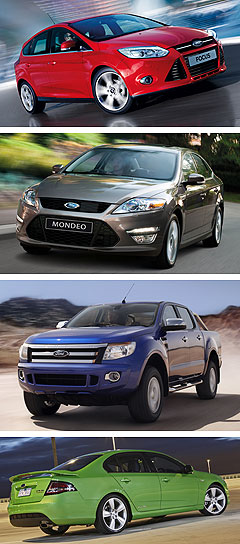News - FordFord to increase global sales 50 per cent by 2015Big ticket: Ford’s Kuga compact SUV will be one of 10 new models to be launched in China by mid-decade. China, small cars to fuel Ford sales growth but Australia’s production role unclear9 Jun 2011 By TERRY MARTIN FORD Motor Co has revealed that it expects its global sales to increase 50 per cent by 2015 to around eight million vehicles a year – up from 5.3 million last year – on the back of continued growth in China and the rise in popularity of small cars. In a series of presentations from senior Ford management to investors and financial analysts on Wall Street this week, the US auto giant said it believed small cars would represent 55 per cent of its total vehicle sales by 2020 (up from 48 per cent now), with almost one-third of its overall sales – 32 per cent – coming from its Asia Pacific and Africa region, which is more than double the current volume. Australia comes under this region but Ford expects the growth to come primarily from emerging markets, notably China, where it will triple its range from five to 15 models by mid-decade, with 95 per cent of these global products such as the Kuga compact SUV. This will see it cover 50 per cent of market segments in China by 2015, up from 22 per cent today, sold through 680 dealers – twice as many as there are now. There is no specific target volume set for the Australian market, and although Ford has abandoned its plan to build the new-generation Focus small car here, the company this week reaffirmed Australia’s status as the lead engineering centre worldwide for compact pick-up trucks.  From top: Ford Focus, Mondeo, Ranger, Falcon. From top: Ford Focus, Mondeo, Ranger, Falcon.However, in outlining the product strategy for the years ahead, Ford’s group vice-president of global product development, Derrick Kuzak, reiterated the commitment to “expanding global platforms and vehicles” and, perhaps ominously for Ford Australia’s engine operations, promising a complete range of all-new EcoBoost engines in all regions worldwide. Ford is yet to announce whether it will build EcoBoost engines in Australia – it will import a 2.0-litre version for Falcon from early next year – and has not made clear its intentions for its entire manufacturing operations in this country past 2016, when the current platform underpinning the Falcon, its derivatives and the Territory SUV reaches the end of the line. There is also no word yet on when exactly the federal government will introduce Euro 5 emissions requirements – a move that should occur by mid-decade and which is expected to herald the demise of Ford Australia’s long-running locally built inline-six engine. Mr Kuzak’s presentation emphasised that “in line with our strategy to provide high-volume solutions, a full range of EcoBoost powertrains will service all regions, with an annual volume of more than 1.5 million units by 2013 calendar year”. Of these, 250,000 will be 3.5-litre V6 engines (ranging from 265-272kW) – a likely replacement for the Australian I6 – and 560,000 will be the 2.0-litre inline-four (149kW-186kW), while 500,000 will be 1.6-litre I4 engines (112-134kW) and 260,000 will be the new 1.0-litre three-cylinder (75-89kW). Ford said this week that its “aggressive restructuring” would continue and see more than 140 per cent of the company’s global product portfolio being either all-new or refreshed by 2014 (compared with 2009). By mid-decade, Ford expects about six million of its global vehicle sales – or about 75 per cent of its total volume – will come from vehicles built on five vehicle architectures: B (light/Fiesta), C (small/Focus), C/D (medium/Fusion/Mondeo), full-size commercial van (Transit) and compact utility/pick-up (Ranger). Lower-priced – and presumably stripped-out – versions of global vehicles will be offered in emerging markets, which are the only areas in which ‘localisation’ is being discussed. It is anticipated that Australia, on the other hand, will fall into line with top management directives and sell the next-generation Falcon off a global platform, probably the same one used for the front-wheel-drive Taurus. In financial terms, Ford’s global operating margins are expected to increase over the period from 6.1 per cent last year to 8-9 per cent. The company also expects to achieve investment grade in the near-term and resume paying dividends as appropriate thereafter. Total automotive debt will be reduced to around $US10 billion, down from $16.6b at the end of the first quarter this year and from $33.6b at the end of 2009. Chief financial officer Lewis Booth said Ford – which did not follow General Motors and Chrysler into bankruptcy during the global financial crisis – would “continue to focus on maintaining healthy, growing operating margins and creating long-term value”. “Maintaining adequate cash to support and grow the business and reducing our debt are essential steps we are taking to achieve and solidify a world-class balance sheet,” he said. Mr Booth also said there were no plans for new acquisitions, with Ford having shed its stable of premium brands in recent years including Volvo, Jaguar, Land Rover and Aston Martin.  Read more3rd of June 2011  Ford prepares three-pot EcoBoost engine for marketFord’s first three-cylinder promises power, economy and low CO2 emissions3rd of June 2011  VFACTS: Holden on top as Toyota comes up shortJapanese quake shortages strangle Toyota sales as Holden grabs a rare win4th of May 2011  Ford will rebound, says CarrFederal minister predicts Ford Australia’s new models will reverse sales slump27th of April 2011  Ford’s star continues to riseNew models, rising sales and reduced debt deliver $2.6 billion Q1 profit at Ford |
Click to shareFord articlesResearch Ford Motor industry news |
















Facebook Twitter Instagram